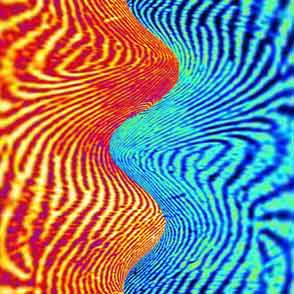 COM.on C.A.1:e14/88-91 Online
published on Oct. 17, 2007.
COM.on C.A.1:e14/88-91 Online
published on Oct. 17, 2007.
 COM.on C.A.1:e14/88-91 Online
published on Oct. 17, 2007.
COM.on C.A.1:e14/88-91 Online
published on Oct. 17, 2007.
doi:10.4236/coca.2007.11014
REVIEW
Review of the Genetics Studies on Human Dermatoglyphy
ZHANG Haiguo
School of Medicine, Shanghai Jiaotong University, Shanghai 200025 China
Editor’s summary: Dermatoglyph is an essential human physical character that could be identified and classified scientifically. Dermatoglyphic patterns have been widely used in individual identification and contributed to diagnosis of some important human genetic disorders. This paper reviewed debates and advances of genetic study for dermatoglyphic patterns. The genetic mechanism is not yet clear today but the study did make progress in the past one hundred years. Recently, with using of whole genome genotyping and linkage analysis, some chromosome regions have been related to human dermatoglyphic patterns. The author also introduced excellent works of Chinese Dermatoglyphics Association. (HE Yungang, Center for Health Sciences, SRI International)
Key words: Dermatoglyph; Heredity; Linkage analysis; Genetic disorders; Twins study
Received: Oct.10,2007 Accepted: Oct.16,2007 Corresponding: zhanghaiguo2002@yahoo.com.cn
《现代人类学通讯》第一卷e14篇 第88-91页 2007年10月17日网上发行
特约综述
人类肤纹遗传研究的回顾
张海国
上海交通大学医学院 上海200025
编辑提要:肤纹是可以被直接观察并进行科学地分类描述与鉴别的重要人类体质性状。肤纹特征已经被广泛地用于个体识别并与人类一些遗传异常联系起来。通过简要回顾过去一百多年来肤纹研究中一些遗传学问题的争论与进展,作者指出,虽然肤纹的具体遗传机制仍然未能阐清,但是该领域的研究一直在困难中前进并取得很大进展。特别是最近几年,通过全基因组基因分型和连锁分析,在染色体上得到了一些和肤纹特征相关的基因候选区域。此外,作者还介绍了中国肤纹协作组在对中国各族群肤纹调查上取得的显著成绩。(何云刚,斯坦福研究所健康 科学中心)
关键词:肤纹;遗传;连锁分析;遗传异常;双生子研究
收稿日期:2007年10月10日 修回日期:2007年10月16日 联系人:张海国 zhanghaiguo2002@yahoo.com.cn
全文链接 Full text: [PDF]
网络资源:DOWN SYNDROME description in OMIM: http://www.ncbi.nlm.nih.gov/entrez/dispomim.cgi?id=190685
参考文献 References
1.张海国(2006)人类肤纹学.上海:上海交通大学出版社,10-31.
Zhang H (2006) Human Dermatoglyphics. Shanghai: Shanghai Jiao Tong University Press.
2. 张海国(2002)中国民族肤纹学.福州:福建科学技术出版社,12-31.
Zhang H (2002) Nationality Dermatoglyphics in China. Fuzhou: Fujian Science Press.
3. Cummins H, Midlo C (1943) Finger Print, Palms and Soles. New York: Dover Publications, 50-100.
4. Reed TE, Borgaonkar DS, Conneally PM, Nance WE, Christian JC (1970) Dermatoglyphics nomogram for the diagnosis of Down’s syndrome. J Pediatr, 77:1024-1032.
5. Schaumann B, Alter M(1976) Dermatoglyphics in medical disorders. New York: Springer-Verlag.
6.郭汉璧(1991)人类皮纹学研究观察的标准项目.遗传,13(1):38.
Guo H (1991) Standard variables of the research of human dermatoglyphics. Hereditas (Beijing), 13: 38.
7. Zhang H, Ding M, Jiao Y, Wang X, Yan Z, Jin G, Meng X, Bai C, Lu Z, Chen R (1998) A dermatoglyphic study of the Chinese population III. Dermatoglyphics cluster of fifty-two nationalities in China. Acta Genetica Sinica, 25: 389-391.![]()
8. Chen YF, Zhang H, Lai CH, Lu Z, Wang Z (2007) A dermatoglyphic study of the Kavalan aboriginal population of Taiwan.Sci China C Life Sci, 50: 135-139. ![]()
9. 陈尧峰,张海国,赖俊宏,陆振虞,王铸钢(2006)台湾原住民噶玛兰人肤纹学研究.中国科学C辑-生命科学,2006,36(5):476-480.
Chen YF, Zhang H, Lai CH, Lu Z, Wang Z (2006) A dermatoglyphic study of the Kavalan aboriginal population of Taiwan.Sci China C Life Sci (in Chinese), 36: 476-480.![]()
10. Li H, Zhang HG, Jin L, Lu DR (2003) Evolution Heredity and Gene-Localization of Interdigital Patterns. J Genet Mol Biol, 14: 252-261.[PDF]
11.Reed T,Viken RJ,Rinehart SA (2006) High heritability of fingertip arch patterns in twin-pairs.Am J Med Genet A, 140:263-271. ![]()
12. Chintamani , Khandelwal R, Mittal A, Saijanani S, Tuteja A, Bansal A, Bhatnagar D, Saxena S (2007) Qualitative and quantitative dermatoglyphic traits in patients with breast cancer: a prospective clinical study. BMC Cancer. 7:44. ![]()
13. Medland SE, Loesch DZ, Mdzewski B, Zhu G, Montgomery GW, Martin NG (2007) Linkage analysis of a model quantitative trait in humans: finger ridge count shows significant multivariate linkage to 5q14.1. PLoS Genet. 3:1736-1744. ![]()